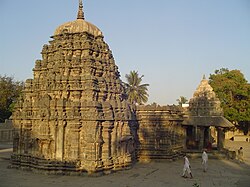Annigeri
| Annigeri ಅಣ್ಣಿಗೇರಿ |
||
|---|---|---|
|
|
||
| State : |
|
|
| State : | Karnataka | |
| District : | Gadag | |
| Location : | 15 ° 26 ' N , 75 ° 26' E | |
| Height : | 630 m | |
| Area : | 11.2 km² | |
| Residents : | 28,267 (2011) | |
| Population density : | 2524 inhabitants / km² | |
| Annigeri - Amruteswara Temple | ||
Annigeri ( Kannada : ಅಣ್ಣಿಗೇರಿ ) is a historically significant city with around 30,000 inhabitants in the Indian state of Karnataka .
Location and climate
Annigeri is located in the northwest of Karnataka on the Dekkan Plateau at an altitude of approx. 630 m ; the city is located about halfway between the district capitals Hubli-Dharwad in the west and Gadag-Betageri in the east. The climate is subtropical and warm; Rain almost only falls in the summer monsoon months .
population
Official population statistics have only been kept and published since 1991.
| year | 1991 | 2001 | 2011 |
| Residents | 25,239 | 25,710 | 28,267 |
Almost 66% of the majority of the Kannada- speaking population are Hindus , around 32.5% are Muslims and around 1% are Jains ; other religions such as Sikhs , Buddhists , Christians etc. form numerically small minorities. The male and female proportions of the population are roughly the same.
economy
The area around Annigeri is largely agricultural; Craftsmen, traders and service providers of all kinds have settled in the city itself.
history
The area around Annigeri belonged in the early Middle Ages to the dominion of the Chalukyas of Badami and the Rashtrakutas ; the oldest inscription found here dates from the middle of the 8th century. As further inscriptions testify, the city came under the sphere of influence of the Chalukyas of Kalyani in the 11th and 12th centuries until the Kalachuri and the Hoysala gradually took power, which was followed in 1348 by the Vijayanagar Empire, which itself in 1565 in the Battle of Talikota was defeated by the combined armies of the Dekkan Sultanates . However, these were divided among themselves and so the Hindu princely state of Mysore was able to take over power for a time, which was contested by the sultans of the Adil Shahi dynasty of Bijapur . From 1761 to 1799 Haidar Ali and Tipu Sultan , two more or less independently ruling generals of the princely state of Mysore, occupied power; thereafter the British extended their influence to southern India.

Attractions
The most important attraction of Annigeri is the Amruteshwara temple , which was consecrated to the Hindu god Shiva and was built in the 11th or early 12th century, but later expanded; it is considered to be the first temple in India built entirely from soapstone and a prototype of all the larger temples of the Chalukyas of Kalyani and the Hoysala. It consists of three merging components: cella ( garbhagriha ), vestibule ( antarala or sukhanasi ) and vestibule ( mandapa or navaranga ). The temple does not rest on a platform ( jagati ), so that the ritual circumnavigation ( pradakshina ) is only possible on the ground level covered with stone slabs. The outer walls of the building are richly structured and ornamented (niches with canopies etc.), but the lack of figures that may never have existed or were destroyed in Islamic times is striking . The cella is elevated by a horizontally stepped tower structure ( vimana ), which ends in a kind of massive "umbrella dome" which - like the metal tip - was probably renewed at a later time. The soapstone pillars of the vestibule are turned and carved; the ceiling segments are decorated with small rosettes ; The Nandi figure, which is obligatory for a Shiva temple, is located directly at the entrance . In the cella there is a lingam made of black stone with a surrounding yoni .
Personalities
The 10th century poet Adikavi Pampa was born in Annigeri.
Others
In 2010, in a sewer than 450 human skulls ( skulls discovered), whose age was indeed investigated but is not uniform.
Web links
- Annigeri, Amrutheshwara Temple - Photos + Info (English)
- Annigeri, Amrutheshwara Temple - Video
- Temple in North Karnataka (English)

